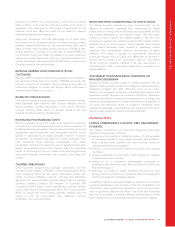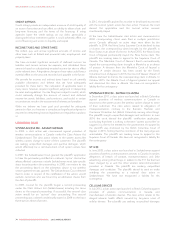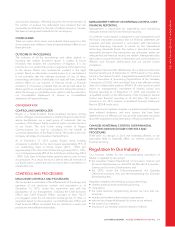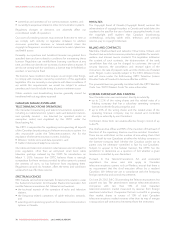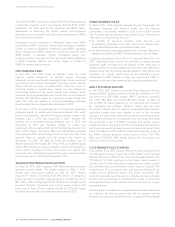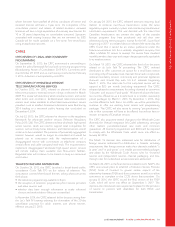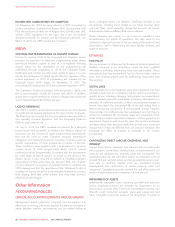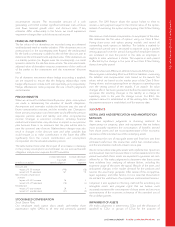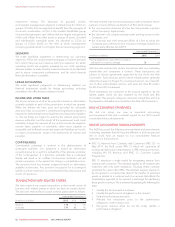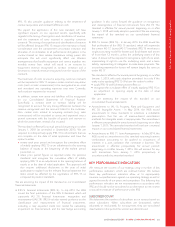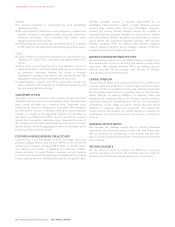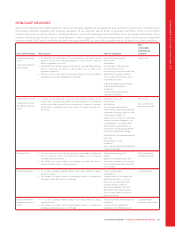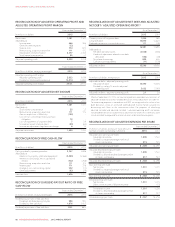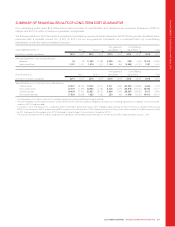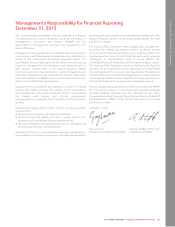Rogers 2015 Annual Report Download - page 82
Download and view the complete annual report
Please find page 82 of the 2015 Rogers annual report below. You can navigate through the pages in the report by either clicking on the pages listed below, or by using the keyword search tool below to find specific information within the annual report.MANAGEMENT’S DISCUSSION AND ANALYSIS
ROGERS NHL GAMECENTRE LIVE GAMEPLUS
On November 20, 2014, we responded to a CRTC complaint by
certain companies claiming that Rogers NHL GameCentre LIVE
Plus, the exclusive content tier of Rogers NHL GameCentre LIVE,
violates CRTC regulations on the basis that it was not content
designed primarily for Internet use by individual customers. On
March 16, 2015, the CRTC denied the complaint.
MEDIA
COPYRIGHT RETRANSMISSION OF DISTANT SIGNALS
Pursuant to section 31(2) of the Copyright Act, television service
providers are permitted to retransmit programming within distant
over-the-air television signals as part of a compulsory licensing
regime. Rates for the distribution of the programming are
established through negotiation or set by the Copyright Board.
Distributors and content providers were unable to agree on a new
rate for the distribution of distant signals after the expiration of the
current agreement in 2013. A proceeding was initiated by the
Copyright Board, which began on November 23, 2015. The
proceeding will continue into 2016 with a decision expected in 2017.
The Collectives (content providers) have proposed a royalty rate
that is approximately double the current rate, which, if certified,
would have a significant financial impact on Rogers with additional
costs of approximately $30 million per year.
LICENCE RENEWALS
The CRTC considers group-based (conventional and discretionary
specialty) licence renewal applications for major media companies.
The Rogers group includes the City conventional television stations
and specialty channels Sportsnet 360, The Biography Channel,
G4Tech, and Outdoor Life.
On July 31, 2014, the CRTC renewed our licences for a two-year
period as we had requested. In addition, the decision placed no
restrictions on the amount of sports programming expenditures
that can be used to meet Canadian program expenditure
obligations and deleted the previous condition of licence requiring
specific expenditures of local programming outside of Toronto.
These conditions were replaced with a requirement to produce
original hours of local programming which cannot include
professional sports programming. Consistent with the requirement
for other large broadcast groups, pursuant to the decision the
Rogers group is now required to achieve a Canadian program
expenditure of 30% rather than the previous 25%, 5% of which
must be directed to programs of national interest. In addition, the
CRTC determined that the imposition of the Wholesale Code as
condition of licence would be an appropriate measure to ensure a
level playing field with other entities that may have business
relationships with Rogers.
Other Information
ACCOUNTING POLICIES
CRITICAL ACCOUNTING ESTIMATES AND JUDGMENTS
Management makes judgments, estimates, and assumptions that
affect how accounting policies are applied, the amounts we report in
assets, liabilities, revenue, and expenses, and our related disclosure
about contingent assets and liabilities. Significant changes in our
assumptions, including those related to our future business plans
and cash flows, could materially change the amounts we record.
Actual results could be different from these estimates.
These estimates are critical to our business operations and
understanding our results of operations. We may need to use
additional judgment because of the sensitivity of the methods and
assumptions used in determining the asset, liability, revenue, and
expense amounts.
ESTIMATES
FAIR VALUE
We use estimates to determine the fair value of assets acquired and
liabilities assumed in an acquisition, using the best available
information, including information from financial markets. These
estimates include key assumptions such as discount rates, attrition
rates, and terminal growth rates for performing discounted cash
flow analyses.
USEFUL LIVES
We depreciate the cost of property, plant and equipment over their
estimated useful lives by considering industry trends and company-
specific factors, including changing technologies and expectations
for the in-service period of certain assets at the time. We reassess our
estimates of useful lives annually, or when circumstances change, to
ensure they match the anticipated life of the technology from a
revenue-producing perspective. If technological change happens
more quickly, or in a different way, than anticipated, we might have to
reduce the estimated life of property, plant and equipment, which
could result in a higher depreciation expense in future periods or an
impairment charge to write down the value. We monitor and review
our depreciation rates and asset useful lives at least once a year and
change them if they are different from our previous estimates. We
recognize the effect of changes in estimates in net income
prospectively.
CAPITALIZING DIRECT LABOUR, OVERHEAD, AND
INTEREST
Certain direct labour, overhead, and interest costs associated with
the acquisition, construction, development, or improvement of our
networks are capitalized to property, plant and equipment. The
capitalized amounts are calculated based on estimated costs of
projects that are capital in nature, and are generally based on a per-
hour rate. In addition, interest costs are capitalized during
development and construction of certain property, plant and
equipment. Capitalized amounts increase the cost of the asset and
result in a higher depreciation expense in future periods.
IMPAIRMENT OF ASSETS
Indefinite-life intangible assets (including goodwill and spectrum
and/or broadcast licences) are assessed for impairment on an
annual basis, or more often if events or circumstances warrant, and
finite-life assets (including property, plant and equipment and
other intangible assets) are assessed for impairment if events or
80 ROGERS COMMUNICATIONS INC. 2015 ANNUAL REPORT





